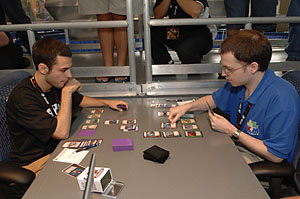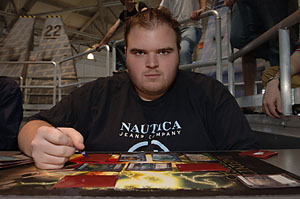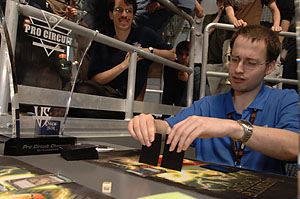
Part 1
Part 2
Part 3
Part 4
Part 5
Thomas Reeves has written more about the deck he created than I’m ever likely to. If you are interested in Deep Green’s evolution or workings, then you really should give his articles a read (part 1 and part 2). I only intend to cover the toolbox aspect of the deck, which is a very small part.
I believe that the correct deck to play at the Pro Circuit is the one with which you are most likely to go 7-3 or better on Day 1. This gives you a solid base to make good money on Day 2 and a shot at Day 3. This belief influenced every one of my deck tuning decisions, including the most controversial ones.
There were thirty-one copies of Enemy of My Enemy in the Top 8. Deep Green was the only deck not running the full complement of four, and the most plausible explanation FTN’s Peter Sundholm could come up with was that I didn’t own four. Actually, I owned two, but there were plenty of players back home willing to lend me more if I’d wanted them.*

On the first day of a Pro Circuit, you’re likely to face a large number of fairly traditional decks and will not need to dig into your toolbox very often. Against these decks, Enemy of My Enemy was almost always used to fetch Spider-Man, The Amazing Spider-Man, who is the deck’s preferred 7-drop. Day 3 is another matter; it’s not unreasonable to think that you’ll need the toolbox against half of the field, and in my case, Ivy League alone filled this quotient. Deep Green would want two copies of Enemy of My Enemy on Day 1 and five copies on Day 3. For a long time, I’d been playing the deck with two copies and was more than happy with the level of consistency that gave me. Most of my teammates were more comfortable with a third copy, and with talk of discard decks being everywhere, I decided to join them.
Now, for the toolbox itself.
 4 Mikado and Mosha, Angels of Destruction
4 Mikado and Mosha, Angels of Destruction
Modern Age had been dominated by off-curve and stunted-curve rush decks, and I was expecting them to make up at least thirty percent of the field this time around. With easy access to Slaughter Swamp, a single copy of Mikado could easily swing the match and was more efficient than running our own 1-drop (who would never be large enough to deal with Joystick, Janice Yanizesh).
Sage, Xavier’s Secret Weapon
The choice between having cards to play and not was a fairly easy one. Against Ivy League, you either make Sage or scoop.
Fatality, Flawless Victory
Total Anarchy on legs may sound like a liability when playing Ahmed Samsarra, White King, but there are a mass of decks that this girl flat-out beats. I was more than a little worried that someone would take a similar gambit and put her in a Squadron deck (against which Samsarra always ends up visible to soak up damage). Fortunately, my fears were misplaced.
Deathstroke the Terminator, Lethal Weapon
Shadowpact made their Golden Age debut one week before the Pro Circuit, and what a debut it was. The combination of making a 4-drop on turn 3 and Cloak of Nabu, Fate Artifact was enough to tame Merlyn, Deadly Archer, so we needed an alternative. We tested Bizarro, ME AM BIZARRO #1, but the 8 endurance difference on the vengeance abilities turned out to be far more important than Bizarro’s extra attack.
Metallo, John Corben
Did I mention being scared of Fate Artifacts? Enter Metallo, who can remove all three in one go and will generally get the stun, too. All he needs is the initiative and a way to attack the relevant character . . .
Sewer System
Flight and the ability to attack concealed characters from a location do quite nicely in a deck that’s painfully low on both. The Morlock-stamped first ability would do little more than earn a few odd looks, but the card works fine without it.
Asmodeus, Duke of Hell
With a 2,000-card pool to build from, there was no way to be sure that there wasn’t an obscenely good control deck out there somewhere, especially since my own deckbuilding efforts had come alarmingly close. No 8-drop was going to help us when Captain Marvel, Champion of Magic or Ghost Rider, Danny Ketch hit the table, so the PC: Amsterdam tech was recycled for its second outing. He turned out to have a blank text box in San Francisco, but he still managed to win a surprisingly large number of games by being the biggest guy on the table.
Sentinels in their day had the best 52-card deck in Golden Age. It was so efficient that it could afford to run eight cards that were useless against half the field. I’d like to think that no deck in Silver Age will ever be powerful enough to make that kind of sacrifice. Instead, players are forced to find cards with additional uses. The characters in the toolbox can be discarded for the cost of any of the seven character searchers. Slaughter Swamp and Sewer System have synergy with Brother Eye, Merlyn, and Maxwell Lord, Black King, and they also give flight to whichever character might need it.
The original plan for Sunday had been to test my board game prototypes with some Canadian friends. After looking over the decklists for the Top 8, I suspected that these plans would only be put back a few hours. The TAWC Checkmate build was more aggressive and more consistent than Deep Green. I’d beaten Donkey Club’s Ivy League on Day 1, but I had been a little lucky and was helped by time being called partway through turn 5. FTN’s Mexican Hardware Store promised to beat down hard and then finish the opponent off with burn.
The only bright points were that neither FTN nor TAWC could attack concealed characters (lacking Hi-Tech Flare Gun and Sewer System, respectively) or threaten to KO a visible King. Deep Green had only one plan for the odd initiatives, which was to use Rook Control to make Ahmed Samsarra, White King visible so that Merlyn, Deadly Archer could hide in the hidden area and keep his cosmic counter. That plan looked viable.
This was as deep as my analysis went. Food and rest were far more likely to make a difference than studying matchups, and besides, this was supposed to be a holiday!
 The first game of the quarterfinal against Tim Batow went exactly as scripted. Tim couldn’t get The Science Spire to remove his King from play and fetch Bizarro, so he under-dropped on turn 4. Spider-Man and Merlyn took care of Deathstroke the Terminator, Ultimate Assassin on turns 7 and 8 respectively, and things were looking good at 1-0.
The first game of the quarterfinal against Tim Batow went exactly as scripted. Tim couldn’t get The Science Spire to remove his King from play and fetch Bizarro, so he under-dropped on turn 4. Spider-Man and Merlyn took care of Deathstroke the Terminator, Ultimate Assassin on turns 7 and 8 respectively, and things were looking good at 1-0.
The second game proved the flaw in the Rook Control plan. The TAWC build was too aggressive and there was no late game for Merlyn and Spider-Man to dominate.
Tim decided that game 3 wasn’t going to go to script; he was going to take a big risk to force through the early damage he needed to cope with the bad initiative. His poker face was superb, and when I activated Merlyn, I had no idea that Tim had missed one of the nine cards he needed. I had KO’d a King for the second time that weekend, and this time, it wasn’t mine! The semifinals beckoned.
 Some estimates of my chances against Gabe Walls and the Ivy League discard deck were as low as ten percent, and my own estimates weren’t much higher. Sage or Fatality might be enough to beat a bad draw, but with generous time limits and a strong opponent, I was going to need both to beat a good draw.
Some estimates of my chances against Gabe Walls and the Ivy League discard deck were as low as ten percent, and my own estimates weren’t much higher. Sage or Fatality might be enough to beat a bad draw, but with generous time limits and a strong opponent, I was going to need both to beat a good draw.
The first game was notable for two things. The first was Gabe’s choice of the odd initiatives, which would allow me to recruit unhindered on turn 4 but would ensure that he could use Enemy of My Enemy and X-Corporation before Sage hit the table. The second was the spectacular implosion of Deep Green that followed my mulligan of a respectable hand in an attempt to hit Sage or Fatality.
At the start of game 2, I had to decide whether Gabe’s decision about the initiative was correct. I had been playing Deep Green for a month and had never done 50 damage in five turns, so I took evens. Some observers might interpret this as a claim that I understood the matchup better than the combined intelligence of Donkey Club, but given my slim chances of winning with either initiative, it would take far too long to prove either way.
The most entertaining moment of the two wins that followed was when Gabe Walls asked me, “Did you do it?” It’s fairly common for poker players to try to get a read on whether their opponent had a good or bad draw. My only training to counter this was from watching episodes of The West Wing. I refused to accept the premise of the question and responded with, “I don’t know what you’re asking,” combining this with a very deliberate grin and genuine amusement at the situation. If Gabe could read a complete stranger through this lot, I was in even worse trouble than everyone thought.
Gabe proceeded to activate Dr. Light, only to walk into my single copy of Slaughter Swamp for the second game running. When I went on to recruit Sage that turn, he responded with, “You really did do it.” Not quite¾I didn’t know that Fatality was in the top two cards of my deck at the time. I had one last scare on turn 6 as I sent Asmodeus, Duke of Hell into Evil Star, Servant of the Star Band. Evil Star was still teamed-up with X-Men, and a single activation of X-Corp: Amsterdam would wreck the attack. Instead, Gabe extended his hand, and I was on my way to the finals.
I wasn’t going to watch the other semifinal. I hadn’t had my daily quota of orange slices or cola from the players’ lounge and can never stand still between matches, both of which made it rather hard to watch games. Vidianto Wijaya winning was good for me. If I was going to lose in the finals, it might as well be to the best player in the room.
 I’m not sure whether the result in the finals says more about how little I understood the matchup or how bad Vidi’s draws were. Rook Control proved useful for the second and third time that weekend, and I won the first two games without losing too much hair.
I’m not sure whether the result in the finals says more about how little I understood the matchup or how bad Vidi’s draws were. Rook Control proved useful for the second and third time that weekend, and I won the first two games without losing too much hair.
In the third game, I got to use the coolest defensive trick in the deck (which came up countless times in testing but hadn’t all weekend): line up Sarge Steel, Knight in front of Talia, Daughter of Madness and put everybody else in the back row. Your opponent will generally play around Sarge Steel’s ability and attack him first, but that’s fine. When your opponent looks like he or she is going to stun one of your other characters, you can Science Spire Sarge Steel back to hand and discard him. Talia’s ability lets you put Sarge back into play in front of your defender, so he’ll stun instead.
This trick saved me a valuable 3 endurance in the third game, leaving me on 5 and just out of range of Die for Darkseid! After the last attack of the game was over (which involved two Merlyn power-ups), I was 1 endurance up and Vidi had one unknown card. I asked whether it was Die for Darkseid!, and Vidi said no and offered his hand. The Pro Circuit had a new Champion, and I went into a state of shock for the best part of two weeks.
I hope you’ve enjoyed the reports as much as I’ve enjoyed reminiscing. If I’ve misrepresented anybody, it’s due to a lack of notes and incompetence rather than malice, and I humbly apologize.
Ian “Runner, Runner” Vincent
* At TheGamesClub in central London and the BushBash in Sheppards Bush.